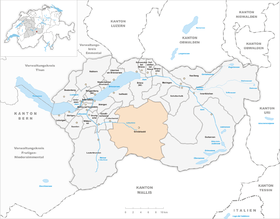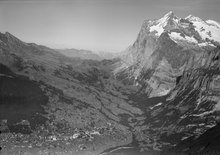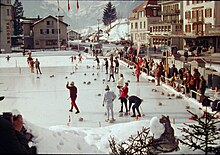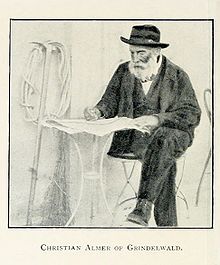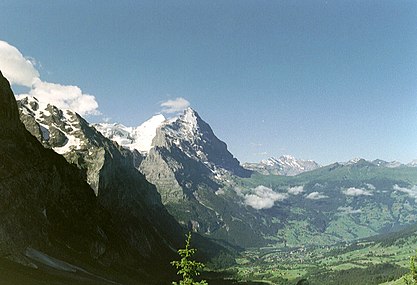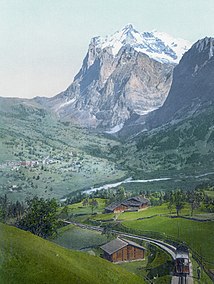Grindelwald
| Grindelwald | |
|---|---|
| State : |
|
| Canton : |
|
| Administrative district : | Interlaken-Oberhasli |
| BFS no. : | 0576 |
| Postal code : | 3818 |
| UN / LOCODE : | CH GRI |
| Coordinates : | 645 546 / 164 014 |
| Height : | 1034 m above sea level M. |
| Height range : | 726-4107 m above sea level M. |
| Area : | 171.38 km² |
| Residents: | 3802 (December 31, 2018) |
| Population density : | 22 inhabitants per km² |
| Mayor : | Beat Bucher (independent) |
| Website: | www.gemeinde-grindelwald.ch |
|
church |
|
| Location of the municipality | |
Grindelwald is a municipality in the Interlaken-Oberhasli administrative district in the canton of Bern in Switzerland .
Surname
The name Grindelwald is an original field name and is made up of the Old High German words grintil (bar, lock) and walt (forest).
history

The Burgbühl in Grindelwald is a high medieval castle site . The Augustinian Provosty Interlaken received from King Konrad III in 1146 . several imperial estates. Interlaken increased this property through numerous acquisitions, displaced the noble families von Rotenfluh, von Ringgenberg, von Eschenbach and von Habsburg-Austria and with sixteen fiefdoms became the most important landlady in the valley. The Reichsvogt Berchtold V von Zähringen defeated the Upperland nobility in Grindelwald in 1191. The people of Grindelwald fought as churchmen in Interlaken in 1315 and 1332 against Unterwalden and finally suffered when the Unterwalden invaded in 1342. In 1348 and 1349 they rebelled against the Interlaken monastery. In 1528 the people of Grindelwald defended themselves unsuccessfully against the introduction of the Reformation by Bern by force of arms . The city of Bern has now replaced the Interlaken monastery as landlady .
Tourism in the village began to develop in the 18th century, the first hotel "Schwarzer Adler" was opened in 1820, the first winter season took place in 1888, and in 1890 the Bernese Oberland Railway started operating . On August 18, 1892, 44 residential buildings and 72 other buildings including the new train station burned down from the Hotel Bär at today's bus parking lot, but the old town center around Gydisdorf was spared, as the sparks from the strong foehn took place down the valley and into the village Schwendi came to fires. In 1893 the Wengernalp Railway started operating , in the same year the newly built Grand Hotel Bear was reopened, it burned down again in 1941 and was not rebuilt. The gondola to the First opened in 1947 , the Pfingsteggbahn followed in 1967 and then in 1978 the Grindelwald – Männlichen gondola .
Grindelwald organized itself in terms of usage rights in the Alps ( mountain regions ). In 1404, Propst Niklaus laid down the alpine pasture conditions in writing for the first time in 1404 in the Einunge und statunge zegrund and at the Alps Bach, Grindel, Holzmatten, Scheidegge, Wergistal, Intremen and zu Gletscher . The Bussalp Alp was excluded from this, as it was owned by the Habsburgs. In 1538, the valley people summarized existing regulations in the valley unification . The mining rights were tied from then on (until now) to the land in the valley and were not allowed to be sold to local residents. The seven existing mountain regions of Itramen, Wärgistal, Scheidegg, Grindel, Bach, Holzmatten and Bussalp were referred to as communities of the Grindelwald valley before 1847. The Bergschaft exist today as private corporations under the law on the introduction of the Swiss Civil Code of May 28, 1911 (Art. 20).
geography
The villages, hamlets and farms of the municipality of Grindelwald are scattered in the valley basin of the Black Lütschine in the Bernese Oberland between the Eiger , Wetterhorn , Fiescherwand and Faulhorn . With an area of 171.1 km², Grindelwald is the twenty-fifth largest municipality in Switzerland and the third largest in the canton of Bern. The highest point is 4107 m above sea level. M. der Mönch , the lowest point is 720 m above sea level. M.
The Lower Grindelwald Glacier and the Upper Grindelwald Glacier lie in the Grindelwald area . Both are tourist attractions and reached before the village in the period from about 1590 to 1880. They feed the Schwarze Lütschine, which drains the valley. A right tributary of the Black Lütschine is for Bachläger waterfall known Milibach .
population
Grindelwald has a permanent resident population of 3,802 people (December 31, 2018). The municipal administration gives slightly higher values (4061 people on January 1, 2017), which also includes weekly residents.
| year | Residents |
|---|---|
| 1669 | 1300 |
| 1737 | 1673 |
| 1764 | 1816 |
| 1799 | 1985 |
| 1850 | 2924 |
| 1880 | 3081 |
| 1900 | 3346 |
| 1910 | 3696 |
| 1930 | 3021 |
| 1950 | 3053 |
| 1960 | 3244 |
| 1970 | 3511 |
| 1980 | 3597 |
| 1990 | 3545 |
| 2000 | 4069 |
| 2010 | 3809 |
economy
The community lives mainly from tourism. Employment is distributed across the three economic sectors as follows : 5.4 percent agriculture, 19.5 percent industry and trade, 75.1 percent services (as of 2000). In 2007 there were still 126 farms.
In winter it is mainly alpine winter sports enthusiasts, in summer hikers and tourists who come because of the mountain scenery. Tourism has a long tradition. Attempts were made early on to make the mountains more accessible to guests. The Wetterhorn elevator is one of the oldest passenger-transporting cable cars in the world. In Grindelwald there are hotels, holiday apartments and chalets, a youth hostel , a youth camp for disabled children and two campsites.
traffic
There is a connection to Interlaken via the Berner Oberland Railways . The Wengernalpbahn runs over the Kleine Scheidegg to Wengen and Lauterbrunnen . From the Kleine Scheidegg there is a connection with the Jungfrau Railway through the Eiger to the Jungfraujoch . The Kleine Scheidegg / Männlichen ski area is accessed by a gondola lift up to the Männlichen ; from there a cable car also leads to Wengen. Another gondola lift leads to the First ski area . Trips over the Grosse Scheidegg into the Haslital are only possible with the Postbus and the bicycle. In summer, a cable car takes you to the Pfingstegg private valley on Mattenberg , the starting point for hikes to the Grindelwald glaciers, to the Schreckhornhütte and to Chalet Milchbach , which can be reached through a hiking trail tunnel . The rock paradise Breitlouwina is on the way .
Mountain railways
- Grindelwald – Männlichen cable car
- Grindelwald - First cable car
- Grindelwald - Pfingstegg cable car
- Cog railway Grindelwald - Kleine Scheidegg (- Jungfraujoch)
bus connections
- Grindelwald - Bussalp
- Grindelwald - Waldspitz
- Grindelwald - Grosse Scheidegg (- Schwarzwaldalp - Meiringen )
- Grindelwald - Wärgistal / Itramen
- Grindelwald - Pfingsteggbahn - Glacier Gorge
- Grindelwald - Terrassenweg (- Ob. Glacier)
Fun on the slopes
From the 1930s Grindelwald possessed the near-center Skischulhang Bodmi about a particular vehicle for winter sports enthusiasts: as Funi (short for "funicular") designated sleigh cable car , which was in 1995 set as the last of its kind.
Sports
Grindelwald was the first health resort in the Bernese Oberland to be visited by tourists in winter from 1888. The guests were able to practice winter sports: initially sleigh rides, curling and ice skating, from 1891 skiing; later a bobsleigh track was built. From 1947 the First was developed as a ski area, in 1978 the Männlichen. From 1932 the SDS races organized by the Swiss Women's Ski Club were held in Grindelwald , which for a long time were among the most important alpine ski races for women and were integrated into the World Cup in 1967 . The last Alpine World Cup races so far took place in 1992.
A Grindelwald invention is the Velogemel , a single-track, steerable sports sledge - comparable to a wooden bicycle with runners instead of wheels.
Culture and sights
Attractions
- Church and rectory, 16th century
- Mountain panorama with u. a. Eiger , Mönch and Jungfrau
- Upper Grindelwald Glacier
- Lower Grindelwald Glacier with Glacier Gorge
- Jungfraujoch
- Bachalpsee
- Grindelwald local history museum
art
Grindelwald is the founding place and seat of the artist group Gilde Schweizer Bergmaler (GSBM). Every few years GSBM events or art exhibitions take place in Grindelwald. Painting courses are offered annually. LandArt Grindelwald is an association that regularly organizes festivals on the subject of art in nature .
Events
Events in Grindelwald include the World Snow Festival , the international Landart Festival , the Eiger Bike Challenge , the Eiger Ultra Trail , ski events and the Velogemel World Championship.
Town twinning
Grindelwald has had a partnership with the mountain village of Azumi Mura (merged with Matsumoto in 2005 ) in Japan since 1972 . The congregations regularly organize exchange trips with large events in order to cultivate friendship.
Location for films
- Scenes for the James Bond film On Her Majesty's Secret Service were shot in Grindelwald, Mürren and on the Schilthorn in the winter of 1968/69 .
- 1972–1974 the television series George was filmed in Grindelwald with Marshall Thompson in the lead role, who had previously had a world success with the series Daktari .
- In 2004, recordings were made in the community for the film Star Wars: Episode III - Revenge of the Sith ; here the filmed mountain scenery represents part of the planet Alderaan , which can be seen in the penultimate scene of the film. The recordings were used to create a mountain backdrop around the capital using blue screen technology and CGI .
Personalities
- Johannes Erb (1635–1701), Protestant clergyman, worked here during the plague year of 1669
- Bernhard Friedrich Kuhn (1762–1825), lawyer, university professor and politician
- Christian Almer (1826–1898), mountaineer
- Gottfried Strasser (1854–1912), “Glacier Pastor” of Grindelwald
- Peter Kaufmann (1858–1924), mountain guide
- Fritz Steuri (1879–1950), mountain guide and skier
- Ernst Nobs (1886–1957), politician, National Councilor, Mayor of Zurich and Federal Councilor
- Samuel Brawand (1898–2001), politician, councilor and national councilor
- Fritz Steuri (1903–1955), mountain guide and skier
- Fritz Kaufmann (1905–1941), ski jumper and Nordic combined athlete
- Adolf Rubi (1905–1988), mountain guide and skier
- Fritz Steuri (1908–1953), mountain guide and skier
- Hermann Steuri (1909–2001), mountain guide and ski racer
- Willy Steuri (1912–1978), ski racer
- Peter Kaufmann (1917–2005), ski racer, Männlichen host
- Erna Steuri (1917–2001), ski racer
- Rudolf Rubi (1918–2004), teacher and local historian, honorary citizen
- Rudolf Bohren (1920–2010), Reformed theology professor in Heidelberg
- Hedy Schlunegger (1923–2003), Olympic champion (1948) in the downhill
- Rosmarie Bleuer (* 1926), ski racer
- Christian Boss (1926–1987), folk musician
- Albert Schlunegger (1938–2000), ski racer and trainer, mountain guide
- Hans Schlunegger (* 1944), ski racer and trainer
- Vreni Inäbnit (* 1948), ski racer
- Dres Balmer (* 1949), author
- Christine Häsler (* 1963), politician, councilor and national councilor
- Georg Schlunegger (* 1980), singer, songwriter, composer
- Martina Schild (* 1981), ski racer, Olympic silver medal (2006) in the downhill
- Daniel Kandlbauer (* 1983), pop musician
- Franziska Kaufmann (* 1987), curling world champion and European champion
Impressions of the mountains around Grindelwald
Grindelwald with the Wetterhorn in winter
Grindelwaldtal with Eiger
Basin from the Lower Grindelwald Glacier
literature
- Fritz Balmer: 850 years of Grindelwald. Pictures and notes for the anniversary year. Grindelwald 1997.
- Anne-Marie Dubler : Grindelwald. In: Historical Lexicon of Switzerland .
- Toni P. Labhart : The Marbles of Grindelwald and Rosenlaui. Grindelwald 2005.
- Toni P. Labhart, Manuel Kehrli: Chimneys made of Bernese marble. Jegenstorf Castle Foundation 2003.
- Michael Matile: Church and rectory of Grindelwald BE. Swiss Art Guide, Series 48, No. 475, Bern 1990.
- Sarah Neuhaus: The new memory of Grindelwald. In: Jungfrau newspaper. Retrieved September 5, 2017 .
- Christian Rubi: The old days up to around 1850. Legal, economic, political, ecclesiastical and cultural conditions. Grindelwald 1985.
- Marianne Tiefenbach: Mountain landscapes in Grindelwald. Alpine care between tradition and modernity. Grindelwald 2006.
Web links
Individual evidence
- ↑ Permanent resident population from STAT-TAB of the BfS , municipalities see also regional portraits 2020 on bfs.admin.ch, accessed on May 29, 2020
- ↑ Bern State Archives, CI a (documents), Interlaken compartment, 23 August 1473
- ↑ Lia Näpflin: The fire disaster of 1892. In: Virgin newspaper. June 16, 2017, accessed March 18, 2020 .
- ↑ Bern State Archives, CI a (documents), Subject Interlaken, March 16, 1404 , Rubi 1985, p. 19.
- ↑ Rubi 1985, p. 21.
- ↑ Taleinungsbrief (2002). (PDF, 86.92 kB) ( Memento of the original from June 19, 2016 in the Internet Archive ) Info: The archive link was inserted automatically and has not yet been checked. Please check the original and archive link according to the instructions and then remove this notice.
- ↑ Permanent resident population from STAT-TAB of the BfS , municipalities see also regional portraits 2020 on bfs.admin.ch, accessed on May 29, 2020
- ↑ Population figures . In: Grindelwald municipality. Retrieved October 7, 2017 .
- ↑ for 2016: permanent and non-permanent resident population by institutional breakdown, gender, nationality and age (permanent resident population). In: bfs. admin.ch . Federal Statistical Office (FSO), August 29, 2017, accessed on October 7, 2017 .
- ↑ for some of the previous years: population figures. In: Grindelwald municipality. Retrieved October 7, 2017 .
- ^ A b Anne-Marie Dubler: Grindelwald. In: Historical Lexicon of Switzerland .
- ↑ Michael Matile: Church and rectory of Grindelwald BE (= Swiss Art Guide. No. 475). Ed. Society for Swiss Art History GSK. Bern 1990, ISBN 3-85782-475-1 .
- ^ Website of the Swiss Mountain Painters Guild
- ^ Website of LandArt Grindelwald


